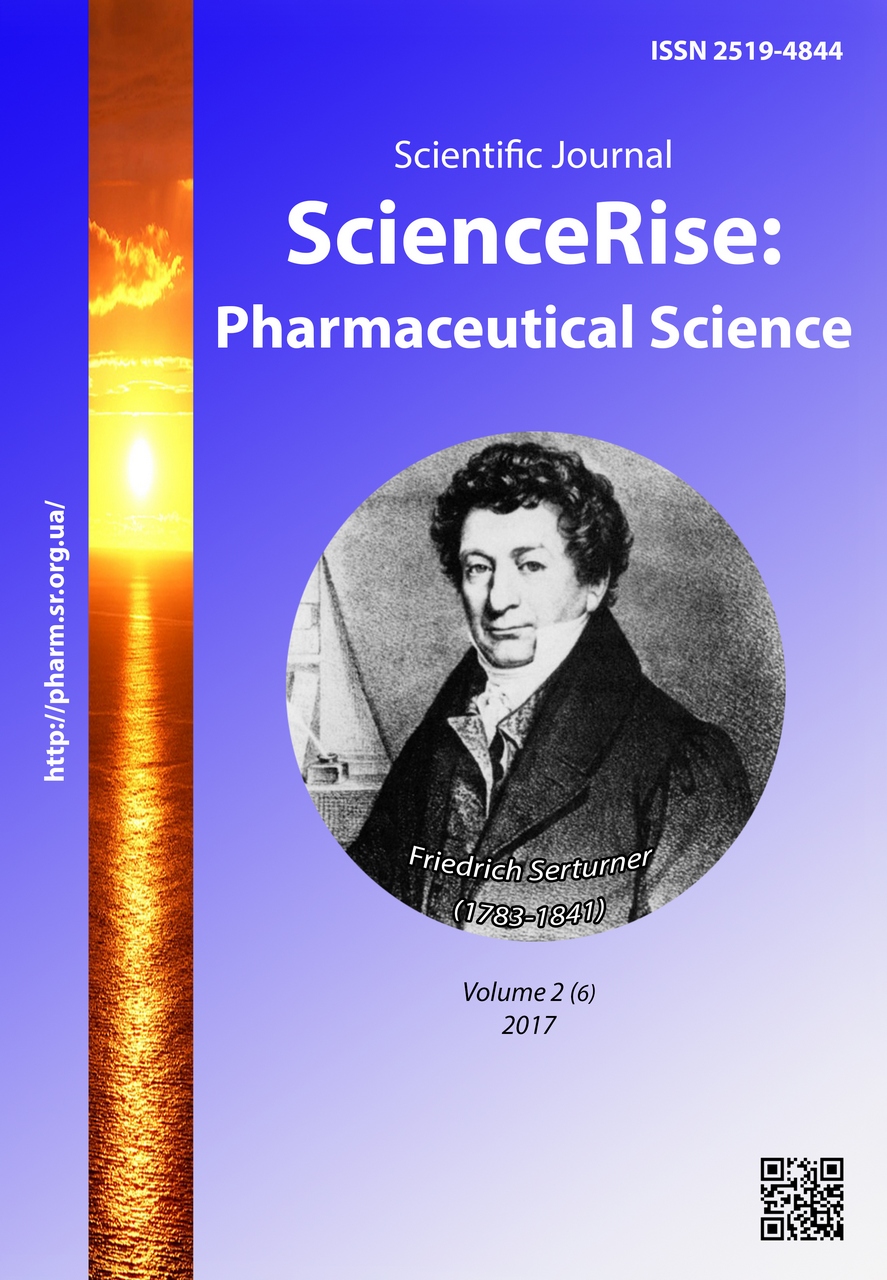Аналіз активності сукцинатдегідрогенази та лактатдегідрогенази при гострій та хронічній гіпоксії на фоні введення похідного 2-бензамідо-2-(2-оксоіндолін-3-іліден) оцтової кислоти
DOI:
https://doi.org/10.15587/2519-4852.2017.98164Ключові слова:
антигіпоксанти, сукцинатдегідрогеназа, лактатдегідрогеназа, гіпоксія, похідні 2-бензамідо-2(2-оксоіндолін-3-іліден) оцтової кислоти, мексидолАнотація
Мета. Вивчити вплив похідного 2-бензамідо-2(2-оксоіндолін-3-іліден) оцтової кислоти ZNM на активність сукцинатдегідрогенази та лактатдегідрогенази біохімічних маркерів енергетичного обміну та гіпоксії в головному мозку щурів за умов гострих гіпобаричної гіпоксії (ГГГ) та нормобаричної гіперкапнічної гіпоксії (НГГ), хронічної гіпобаричної гіпоксії (ХГГ).
Матеріали та методи. Дослідження проводили на 80 білих нелінійних статевозрілих щурах-самцях масою 180–200 г. ГГГ моделювали в проточній барокамері шляхом імітації підйому щурів на «висоту»12000 м. На «висотному плато» щурів витримували до моменту другого агонального вдиху, після чого здійснювали «спуск» на попередню нульову висоту.
НГГ відтворювали шляхом вміщенням щурів до герметичної камери об’ємом 1000 мл та оцінювали тривалість перебування щурів в закритій камері з моменту закриття контейнеру до другого агонального вдиху.
ХГГ моделювали в проточній барокамері шляхом імітації підйому щурів на висоту4000 мнад рівнем моря. На цій «висоті» тварин утримували впродовж 2-х год щоденно протягом 4-х тижнів, сеанси гіпоксії здійснювалися в ранішні години доби.
Речовини, що досліджували, вводили внутрішньоочеревинно за 35 хв. до моделювання гіпоксії. Досліджувану речовину ZNM вводили в дозі 15 мг/кг у вигляді водної суспензії, стабілізованої полісорбатом 80. Референс-препарат антигіпоксант мексидол вводили в дозі 100 мг/кг. Інтактним тваринам вводили еквівалентну кількість води для ін’єкцій з полісорбатом 80. Групам тварин, яким моделювали ХГГ, препарати вводили, починаючи з 14 доби моделювання гіпоксії.
Результати. Активність сукцинатдегідрогенази, при введенні речовини ZNM, в залежності від типу гіпоксії достовірно зростала у групі ГГГ в 2,6 рази, а в групі НГГ – в 1,6 раз в порівнянні з групами модельних патологій. А при введенні мексидолу показники активності зростали у групі ГГГ в 2,9 рази , НГГ – в 1,7 раз, ХГГ – в 1,3 раз.
У той же час активність лактатдегідрогенази при введенні речовини ZNM та мексидолу знижувалася у групі ГГГ в 1,5 раз, НГГ – в 1,3 раз (в 1,5 раз при введенні мексидолу). За умов ХГГ активність лактатдегідрогенази після введення мексидолу не змінювалась, а після введення речовини ZNM незначно, але статистично вірогідно знижувалась на 7,5% у порівнянні з показниками модельної патології.
Висновки. Речовина ZNM та референс-препарат мексидолу нормалізують активності сукцинатдегідрогенази та лактатдегідрогенази, що свідчить про покращення стану енергетичного обміну клітин при гострій і хронічній гіпоксії
Посилання
- Usenko, L. V., Tsariov, O. V. (2016). Modern Opportunities of Energy Protection in Critical States. Emergency medicine, 4 (75), 72–78. doi: 10.22141/2224-0586.4.75.2016.75820
- Novykov, V. E., Levchenkova, O. S. (2013). Novye napravlenyya poyska lekarstvennykh sredstv s antyhypoksycheskoy aktyvnostʹyu y mysheny dlya ykh deystvyya. Eksperymentalʹnaya y klynycheskaya farmakolohyya, 76 (5), 37–47.
- Levchenkova, O. S., Novykov, V. E., Pozhylova, E. V. (2012). Farmakodynamyka y klynycheskoe prymenenye antyhypoksantov. Obzory po klynycheskoy farmakolohyy y lekarstvennoy terapyy, 10 (3), 3–12.
- Rukan, T. A., Maksymovych, N. E., Zymatkyn, S. M. (2013). Aktyvnostʹ nekotorykh fermentov v neyronakh frontalʹnoy kory holovnoho moz·ha krys v rannyy postyshemycheskyy peryod. Vestnyk VNMU, 12 (2), 50–54.
- Tsubanova, N. A., Shtryhol, S. Yu., Horbach, T. V. (2012). Vplyv spirotsyklichnoho pokhidnoho oksindolu na pokaznyky tserebralʹnoho enerhetychnoho obminu v umovakh hipoksychnoyi ta nehipoksychnoyi patolohiyi. Klinichna farmatsiya, 16 (4), 51–54.
- Kolisnyk, S. V., Kononenko, N. P., Haman, D. V., Kotenko, O. M. (2011). Zv'yazok "struktura-antyhipoksychna aktyvnistʹ" u ryadu pokhidnykh 2-benzamido-2-(2-oksoindoliniliden-3)-otstovoyi kysloty. Visnyk farmatsiyi, 4, 64–66.
- Zamorskii, I. I., Bukataru, Yu. S., Lenga, E. L., Kolisnyk, S. V., Altukhov, О. О. (2016). Screening of derivatives of 2-(benzoyilamino)(1-r-2-oxoindolin-3-ylidene)acetic acid under the conditions of acute hypobaric hypoxia. News of pharmacy, 1, 67–70.
- Vazhnycha, O. M. (2001). Antystresorna aktyvnistʹ meksydolu i rolʹ strukturnykh komponentiv preparatu v yiyi realizatsiyi. Klinichna farmatsiya, 5 (2), 60–63.
- Poshuk i eksperementalʹne vyvchennya potentsiynykh protyhipoksychnykh zasobiv (2002). Kyiv: Ministerstvo okhorony zdorovʺya. Derzhavnyy farmakolohichnyy tsentr, 27.
- Pasevych, S. P., Zamorsʹkyy, I. I. (2014). Antyoksydantnyy potentsial pokhidnykh 3-oksypirydynu za umov khronichnoyi hipoksychnoyi hipoksiyi. Ukrayinsʹkyy biofarmatsevtychnyy zhurnal, 5, 9–12.
- Kamyshnykov, V. S. (2009). Spravochnyk po klynyko-byokhymycheskym yssledovanyyam y laboratornoy dyahnostyke. Moscow: MEDpress-ynform, 896.
##submission.downloads##
Опубліковано
Як цитувати
Номер
Розділ
Ліцензія
Авторське право (c) 2017 Іgor Zamorskii, Yuliana Bukataru, Svitlana Melnychuk

Ця робота ліцензується відповідно до Creative Commons Attribution 4.0 International License.
Наше видання використовує положення про авторські права Creative Commons CC BY для журналів відкритого доступу.









